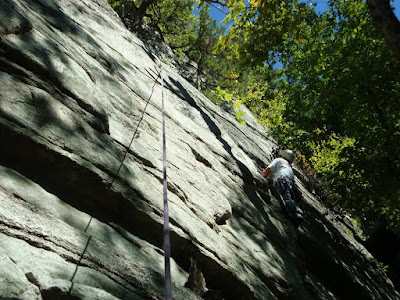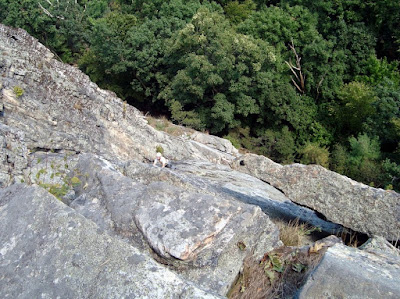Skytop cliff and its tower
Driving towards the Shawangunk Ridge from New Paltz at this time of year, you can't help being struck by the bounty of late summer. Apples, gourds, sunflowers, early pumpkins and late-season corn seem to overflow from the orchards, fields, barns and roadside stands. Jason and I were after a different harvest, however: the Shawangunk Ridge contains the highest concentration of rock climbing routes on the East Coast.
Pumpkins fill wooden crates at the Jenkins-Lueken farmstand
We had been trying to connect since mid-summer for a day of climbing in the Gunks, and our calendars finally matched up. Our agenda was simple: a laid-back day of easy climbing on high quality rock.
Jason climbing Rhodo
Rhododendron was our warm-up climb, a short 5.6- straight-on crack line. Rhodo’s vertical crack provides plenty of opportunities for easy-to-place protection, so it’s a perfect warm-up for guys like Jason and me who have only been out climbing a handful of times this summer. Today was my second climbing day this year, so two makes a handful, right?
Sunflowers line Route 299 at Wallkill View Farm Market
Jason on BD pitch 1
Following Rhodo, we headed down the cliff for some fun moves on Beginner’s Delight (BD), a high quality multi-pitch climb that invariably feels more difficult than its 5.3 rating. BD has plenty of steep, exposed climbing and a traverse section that makes BD less of a delight for some beginners, yet the holds seem to appear just where you want them, accounting for BD’s relatively easy 5.3 rating.
Rolling farmland and woods of the Wallkill valley
Jason on BD pitch 2
The cliffs of the Shawangunk ridge are composed of a textured quartzite conglomerate that provides horizontal fractures and in-cut holds. The suitability of this rock for climbing gives rise to literally hundreds of climbing routes spread over four main cliffs: the Trapps, the Near Trapps, Skytop and Millbrook.
Apples for sale at Jenkins-Lueken Orchards
The Gunks were “discovered” for climbing in the mid-1930’s by Fritz Weissner, and in the following years he and his climbing partner Hans Kraus pioneered many of the routes that are considered Gunks classics today. Using the primitive equipment of the day (hemp rope, soft iron pitons, rope-soled shoes) they put up climbs like Horseman and High Exposure (both in 1941) that still intimidate climbers, even with the advantages of modern climbing technology. Think about these guys next time you’re on the cliff gripped and whimpering, 20 feet above your last piece of solid gear.
Jason pauses between pitches on the GT Ledge
There’s plenty more to do in the Gunks than “just” climbing. See James’ excellent trip report from Minnewaska State Park a few months ago for some more photos and information about mountain biking and hiking there and at the adjoining Mohonk Preserve. Extensive information about climbing, hiking and other outdoor recreation in the region can also be found at Gunks.com.










Sick Bird Rider said...
ReplyDeleteGreat report, Jeff. I climbed many times at the Gunks, though it was many years ago. The experience of leading the final pitch of High Exposure is indelibly burned in my memory. It's not that hard but is it ever SCARY.
If you haven't done it already, you guys might enjoy Yellow Ridge, over on the Near Trapps. It's another one of the classic "Weissner Routes," rated 5.7. I remember it as very committing but very satisfying.
September 17, 2010 8:49 AM
Jamesdeluxe said...
No way around it, the Gunks rule. There's no bad time to go, but late summer is always a favorite.
A few days ago, I was thinking of this ride from two years ago. Has the same lighting as your pix.
September 17, 2010 3:39 PM
Harvey44 said...
Beautiful pics and a sweet report. Another question from a non-climber ... while I think I have an idea about what might make "quality rock" ... what is a climbers definition of the term?
September 17, 2010 6:25 PM
Jason said...
When climbers usually refer to the "high quality rock". They usually are talking about rock that doesn't fracture easily. They might also be referring to the texture. Is the rock slippery to the touch. You don't want rock that is like sand paper either. That just makes for bloody hands.
The rock at the Gunks doesn't crack easily and offers just right amount of fiction. Also it very pretty rock, lots of quartz and other interesting things in it...
September 17, 2010 7:47 PM
Jeff said...
SBR, I backed down from that pitch on High E while leading it a number of years back. I made the crux move out from under the roof and onto the face just fine, but started up the face to the right and it just felt WAY too exposed and scary. What I forgot was that the 5.6 High E line goes up and to the LEFT: important beta! Went back a few years later and followed that pitch and loved it. The thought of leading that still intimidates me, but it is something I will have to do some time.
Haven't done Yellow Ridge, but I have done many of the other classics up to around the 5.7 level. C'mon down and lets tackle High E together.
James, I enjoyed looking at that TR you linked, plus your report from earlier in the summer.
Thx for answering Harv's question Jason.
September 17, 2010 9:41 PM
Sick Bird Rider said...
Thanks for the invitation, I'll start training now. Haven't done any serious climbing for over ten years!
September 17, 2010 11:20 PM
Sick Bird Rider said...
(re-posted, needed to add something)
When I lead HE, I was 23 and 20 pounds lighter. When my partner got to the top, we sat there for about 20 minutes, giggling hysterically from the adrenaline rush. Almost 30 years later, the thought of doing it again is very intriguing. You lead, I'll belay.
On further reflection, I would like to point out that Jeff's downclimbing the crux of High Exposure would take more nerve than finishing the rest of the pitch. Jeff, you are a hard-man! Climbing down is way harder than climbing up, IMHO. For you non-climbers out there, imagine climbing down a slightly overhanging ladder that is 200 feet up in the air. When (if) you look between your legs, all you can see are the treetops below. At the bottom of the ladder, you have to blindly step IN about 3 feet to the next ladder, then scuttle sideways like a terrified crab to the safety of a big ledge. Not to mention the fact that if you fell, your rope would probably get cut by sharp edge of the ledge below before your belayer could catch you. That is what is meant by "exposure" in climbing and that's what I meant by SCARY. Climbers call this being "gripped." As in, "hey, man, how was that down-climb?" Reply: "Dude, I was pretty gripped up there."
September 18, 2010 1:17 PM
Jason said...
ReplyDeleteIt is very hard to describe in words what goes through a leaders mind when he or she is "gripped up"..It all about controlling the panic.
If your able to work out of your predicament and complete the climb, it is a feeling like no other..
When your skiing the biggest rush usually comes when your moving fast . In climbing you get a huge adrenaline rush , basically standing still.
September 18, 2010 1:36 PM